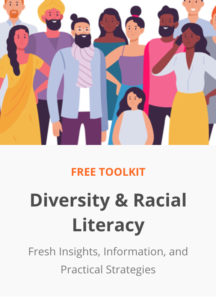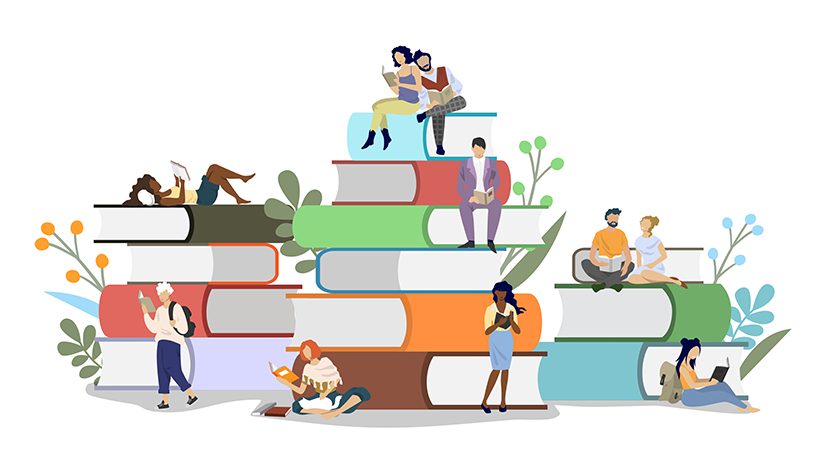We recently met with Sue Maniloff, VP Business Development at Omnigraphics, a reference publisher, to discuss the importance of diversity resources for schools and libraries. Omnigraphics’ new work Understanding and Navigating Discrimination in America has just been added to Infobase’s Credo Reference and Source Reference, and we were eager to get Sue’s perspective. Here are the highlights from our discussion. And check out our webinar with Sue on unpacking new diversity titles!
What are the key factors to be considered when thinking about adding diversity titles to a collection?
Sue: It’s important to keep in mind the demographics of both your own school or library along with the demographics of the general population in the U.S. Fifty percent of schools have more than 50% of a diverse student base as of 2017, according to the National Center for Education. Students of color made up just 29.6% of the undergraduate student population in 1996, which increased to 45.2% in 2016, according to the American Council of Education. These are very telling metrics—it’s very apparent that the need for content to help educate and provide historic perspective on discrimination continues to grow as does the need for racial literacy.
 In your experience, when talking with educators and librarians, are you hearing that they are looking for additional books with diverse characters along with nonfiction reference material on diversity?
In your experience, when talking with educators and librarians, are you hearing that they are looking for additional books with diverse characters along with nonfiction reference material on diversity?
Sue: Definitely yes. There is a big push in education to build diversity collections of all types including fiction, nonfiction, reference, history, poetry, adventure, literature, and more. Collections are being developed so students can both see themselves in the books they read as a sort of mirror, and also as a window, so readers can see other points of view. Recent studies have indicated that the majority of books continue to feature predominantly White characters although school populations continue to grow more diverse. Books help readers understand what it’s like for people who don’t share their race, religion, sexual orientation, or socioeconomic status. Diverse books teach empathy.
Do you have any suggestions for how schools and libraries can best assess the current level of diversity content in their collections and identify which gaps need to be filled?
Sue: We recommend conducting a Diversity Audit in order to gather important, data-driven insight into current collections. Regardless of how well we think we are doing, our unconscious biases get in the way. A Diversity Audit holds collection developers accountable and encourages managers to fill in gaps, being more inclusive when building out collections. It’s an essential tool for developing insight and awareness and helps to identify opportunities for improvement by uncovering what types of new diversity resources need to be added. We are hearing that there is often additional budget available for new diversity content, too!
Catch our video interview with Sue Maniloff here!
As we know, workloads are heavy, and departments are lean and pulled in many directions. Can you share any insight regarding efficiently structuring a Diversity Audit so the time requirement doesn’t make it an impossible task?
Sue: We have found that Diversity Audits are best executed when a few key points are established before beginning the process:
- Make it a priority, tying departmental goals to the project.
- Develop a measurable and attainable plan with realistic deadlines and objectives.
- Keep it simple, starting with specific areas within the collection—for example, young adult titles, or nonfiction titles.
- Assign a project lead for accountability, progress tracking, and success.
- Create a Diversity Audit review schedule to ensure continuous improvement.
What is the main objective of conducting a Diversity Audit?
Sue: A successful Diversity Audit will help identify content gaps in a collection. It will become much more evident if there is a wide variety of points of view, experiences, and representations within a collection, or if it needs to be further developed to increase the level of diversity and inclusion.
Have you seen any best practices that can help with sourcing the right diversity content to help fill the gaps?
Sue: In my opinion, there are two key elements that lead to a best practice when building out a diversity collection:
- Consider not only the community you are serving, but also demographic trends, national education needs, and current events throughout the country.
- Be receptive to getting out of the comfort zone of purchasing content only from established book imprints, and consider relevant diversity content from new publishers, new bundles/collections, new formats, and new voices as well.
 Sue Maniloff is a seasoned professional who has been working within publishing, aggregation, and education technology for decades. She has expertise in developing publishing strategies that complete collections and fulfill gaps, best serving the needs of students and library patrons. As VP Business Development at Omnigraphics, she publishes nonfiction and reference content for schools and libraries.
Sue Maniloff is a seasoned professional who has been working within publishing, aggregation, and education technology for decades. She has expertise in developing publishing strategies that complete collections and fulfill gaps, best serving the needs of students and library patrons. As VP Business Development at Omnigraphics, she publishes nonfiction and reference content for schools and libraries.
See also:
- Integrating Racial Literacy in Your Library Program: Resources for Consideration
- Resources for Libraries Serving Immigrant Patrons
- Thinking about Racial Equity in Libraries
- Check out Infobase’s Diversity Toolkit
- LJ Webcast: Diversity, Equity, and Inclusion in the Public Library
- Supporting Diversity with Infobase: Resources to Inform on Issues of Race, Gender, and Culture: Webinar
- Resources to Inform: Diversity and Inclusion in the Public Library: Webinar


